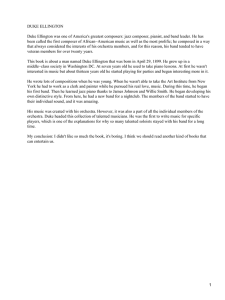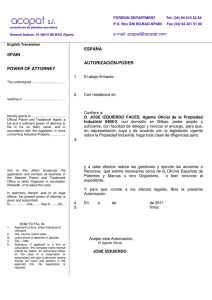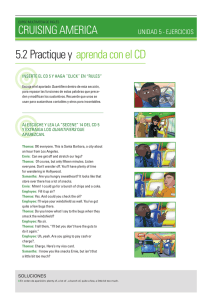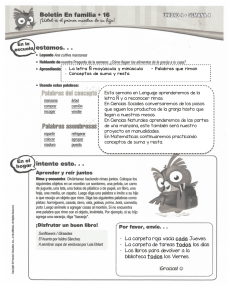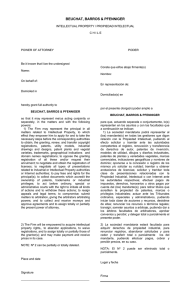organizacion mundial de la propiedad intelectual
Anuncio
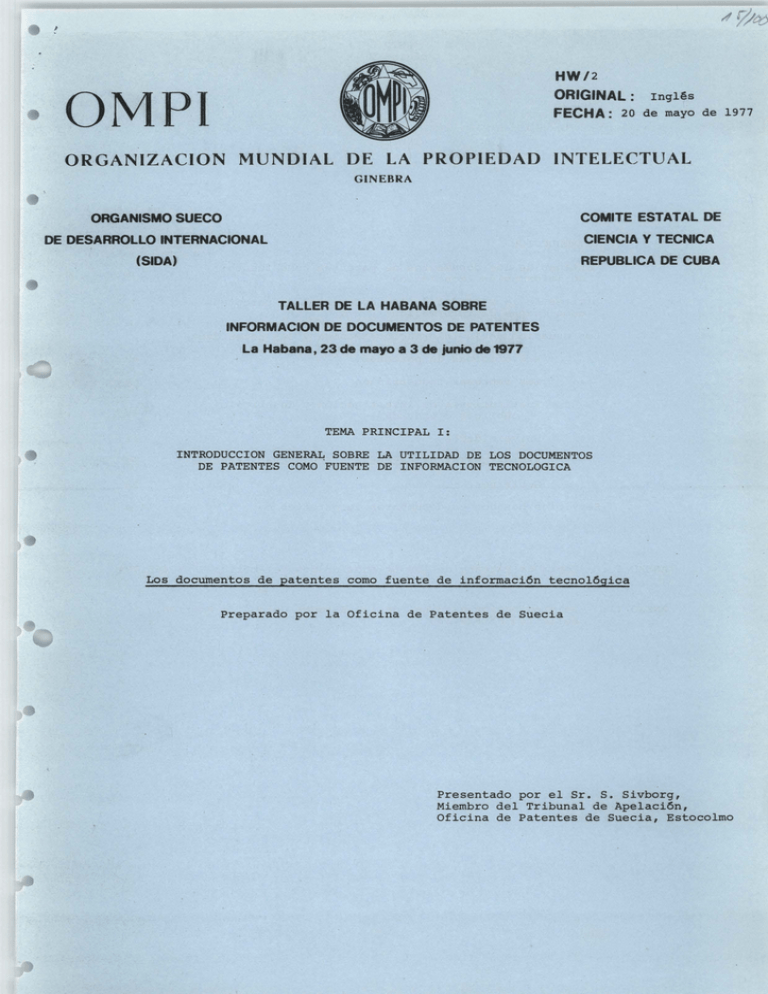
HW/2 ORIGINAL : OMPI IngH!s FECHA: 20 de mayo de 1977 ORGANIZACION MUNDIAL DE LA PROPIEDAD INTELECTUAL GINEBRA ORGANISMO SUECO COMITE ESTATAL DE DE DESARROLLO INTERNACIONAL CIENCIA Y TECNICA (SIDA) REPUBLICA DE CUBA TALLER DE LA HABANA SOBRE INFORMACION DE DOCUMENTOS DE PATENTES La Habana, 23 de mayo a 3 de junio de 1977 TEMA PRINCIPAL I: INTRODUCCION GENE~ SOBRE LA UTILIDAD DE LOS DOCUMENTOS DE PATENTES COMO FUENTE DE INFORMACION TECNOLOGICA Los documentos de patentes como fuente de informaci6n tecnol6gica Preparado por la Oficina de Patentes de Suecia Presentado por el Sr. s. Sivborg, Miembro del Tribunal de Apelaci6n, Oficina de Patentes de Suecia, Estocolmo HW/2 pagina 2 IN DICE Parrafos 1 a 5 INTRODUCCION Ventajas de los documentos de patentes como fuente de inforrnaci6n tecnol6gica 6 L!mites de la utilidad de los documentos de patentes como fuente de inforrnaci6n 7 Los usuaries de la informaci6n tecnica y sus necesidades Las oficinas de patentes 8 Las empresas industriales 9 Instituciones de investigaci6n (publicas o privadas) y desarrollo 10 Universidades 11 Profesionales de patentes e inventores privados 12 Gobiernos 13 Servicios basados en documentos de patentes 14 a 17 ANEXO . I Copia de Patente de los Estados Unidos de America N2 3.465.794 ANEXO II: Reivindicaci6n original de los Estados Unidos de America, solicitud N2 529.302 HW/2 pagina 3 LOS DOCUMENTOS DE PATENTES COMO FUENTE DE INFORMACION TECNOLOGICA INTRODUCCION 1. Una patente otorga un derecho exclusive a su titular para explotar la invenci6n para la que se concede la patente. Concede la patente algun tipo de oficina de propiedad industrial. Hay dos razones para conceder patentes: a) La primera es que un inventor merece que se le otorgue, como remuneraci6n, un derecho exclusive a explotar su invenci6n. b) La segunda es que el desarrollo tecnol6gico se acelera mediante el intercambia de experiencias. Este intercambio de experiencias se logra cuando se publica una invenci6n. 2. En algunos paises s6lo se concede una patente despues de que una oficina de propiedad industrial ha exarninado la solicitud y solo en la medida en que, sabre la base de ese examen, se compruebe que la invenci6n reivindicada es realmente nueva y "representa un avance inventive", es decir, que es sustancialmente original. En esos paises, hay con frecuencia una diferencia sustancial entre el contenido y el ~bito de la solicitud y los de la patente, ya que el exarnen fuerza a menudo al solicitante a aclarar y limitar sus reivindicaciones y su descripci6n originales. En otros pa!ses, se concede la patente sin -o casi sin- exarnen de la solicitud en cuanto a la originalidad de la invenci6n reivindicada. 3. Cuando se concede una patente, las oficinas de propiedad industrial de la mayor!a de los paises que tienen esas oficinas publica un docurnento de patente, lo que significa que se hacen capias de ella y se venden a cualquier persona que desee adquirirlas. En algunos paises, las solicitudes se publican de ordinaria dentro de los 18 meses despues de haber sido registradas (o, si se han registrado solicitudes para la misma invenci6n en otros paises, dentro de los 18 meses a partir del primer registro). 4, La especificaci6n de la patente, es decir, el docurnento concedido y la solicitud de la patente, que es la base para la misma, son redactadas en principia por el solicitante. Muchas solicitudes contienen dibujos para explicar mejor la invenci6n. La mayoria de las leyes de patentes requieren que la solicitud contenga "reivindicaciones" y una "descripci6n". Las reivindicaciones declaran en lenguaje concise lo esencial de la invencion, es decir, los elementos que la distinguen de lo que ya es conocido. Mas exactamente, las reivindicaciones declaran la nueva materia para la que el solicitante desea protecci6n. La des.cripci6n explica la invenci6n (las reivindicaciones) indicando el "estado de la tecnica", es decir, lo que ya era conocido antes de hacerse la invenci6n, describiendo el avance de conocimiento que representa la invenci6n y dando informacion adicional, que es Gtil en el momenta de decidir si la invencion es realmente nueva. Generalmente se requiere que la solicitud sea suficientemente clara y completa para que una persona especializada en la esfera de la industria a la que se refiere pueda, sabre la base de la solicitud, producir el ingenio o realizar el proceso en ella descrito ("ejecutar la invencion"). En el anexo I se muestra una patente de los Estados Unidos y en el anexo II las reivindicaciones de la solicitud correspondiente, Por estos anexos puede verse que la reivindicacion principal se ha limitado considerablemente y algunas reivindicaciones se han cancelado en la patente. Sin embargo, en este caso no se han carnbiado la descripcion ni los dibujos. 5. En este estudio se utilizara la expresion "documentos para los docurnentos que constituyen patentes o solicitudes veces tarnbien para los documentos relatives a certificados de utilidad y otros documentos que normalmente se incluyen queda de las principales oficinas de patentes. de de de en patentes", no solo patentes, sino a inventor, modelos los fondos de bus- Ventajas de los docurnentos de patentes como fuente de informacion tecnologica 6. Las ventajas de los docurnentos de patentes como fuente de informacion tecno16gica apareceran ser las siguientes: a) Los docurnentos de patentes llevan "simbolos de clasificaci6n". Para los fines de mantener fondos de busqueda y realizar busquedas del estado de la tecnica, las oficinas de patentes clasifican los documentos de patentes segun el campo, o HW/2 pagina 4 campos, de tecnologia con el que se relaciona su contenido. Existe un nfirnero de sistemas diferentes de clasificaci6n nacional. Se ha establecido una Clasificaci6n Internacional de Patentes (IPC) por un arreglo intergubernamental y es aplicada en la actualidad por lo menos en 40 oficinas de patentes. Esta clasificaci6n permite la recuperaci6n de los docurnentos de patentes que pertenecen a un campo determinado de la tecnologia. b) Los docurnentos de patentes !levan una fecha de la que se pueden sacar conclusiones sabre la antigliedad de una invenci6n y la cuesti6n de si las invenciones que describen se hallan aun legalmente protegidas. Si ya no son legalmente protegidas, pueden ser utilizadas sin el consentimiento del poseedor de la patente. c) Los docurnentos de patentes tienen una presentaci6n relativamente uniforrne en lo que se refiere a la composici6n y a los datos bibliograficos, y frecuentemente tienen dibujos aclaratorios. Las reivindicaciones indican cual puede ser la esencia de la invenci6n. Dado que la descripci6n debe ser tal que el especialista pueda realizar la invenci6n en base al docurnento de patente, la consulta de docurnentos de patentes permite su realizaci6n, siempre en teoria, y a menudo en la practica. d) Los docurnentos de patentes divulgan inforrnaci6n tecnol6gica porque describen las invenciones con arreglo a las exigencias de la ley de patentes aplicable y porque indican la novedad y la actividad inventiva reivindicadas mediante referencia al estado actual de la tecnica. Son, por tanto, fuente de inforrnaci6n no s6lo sabre lo que es nuevo (la invenci6n) sino tarnbien sabre lo que es conocido y, en muchos casas, dan una resefia hist6rica, en forma resurnida, del progreso tecnol6gico en el campo con el que se relacionan. e) Los docurnentos de patentes divulgan la inforrnaci6n antes que otras fuentes docurnentales de informaci6n tecnol6gica, tales como revistas t€cnicas. Por lo menos en algunos de los paises en lo que se hacen solicitudes de invenciones importantes, los docurnentos son rapidamente publicados (desde unos 3 meses despues del registro de la solicitud en el pais, a 18 meses despues de la primera solicitud en cualquier pais) • Esta publicaci6n de los docurnentos tiene como finalidad compensar el largo retraso en el examen de las solicitudes. El publico debe tener acceso a las invenciones dentro de un plaza de tiempo razonable. f) Muchos docurnentos de patentes contienen un extracto. Los extractos dan una idea general del contenido del docurnento en unos segundos o minutes y, en cualquier caso, en mucho menos tiempo que el necesario leyendo todo el texto del docurnento de patente. g) Los docurnentos de patentes que pertenecen a la misma familia*estan frecuenternente en varios idiomas diferentes. El lector puede elegir el docurnento que esta en el idioma que le es m3s familiar. h) Los documentos de patentes indican el nornbre y la direcci6n del solicitante, del receptor de la patente y del inventor, o al menos uno o dos de ellos. ESta5 indicaciones permiten a un licenciatario potencial contactar a las personas concernidas para ver en que condiciones podria ser autorizado a explotar la invenci6n. i) Los docurnentos de patentes que pertenecen a una determinada subdivisi6n de la clasificaci6n contienen un surninistro altamente concentrado de informaci6n en general tecnicamente avanzada sabre el campo tecnol6gico respective. j) Los docurnentos de patentes a menudo contienen inforrnaci6n que no seria divulaada a traves de articulos o revistas, ya que dicha informaci6n es s6lo divulga a en consideraci6n a la protecci6n legal que la patente confiere. k) Los docurnentos de patentes a menudo divulgan no s6lo conceptos relatives a la utilidad general de la invenci6n, sino generalmente tarnbien inforrnaci6n detallada sabre la posibilidad de su aplicaci6n practica en la industria. * Los docurnentos de patentes publicados en diferentes paises, pero relatives a la misma invenci6n, se conocen en general como familia de patentes. HW/2 pagina 5 i) La mayor parte del alto coste de procesado y clasificacion de los documentos de patentes contenidos en los fondos de bfisqueda y el mantenimiento al dia del sistema de clasificacion es soportado directamente por las oficinas de patentes que publican gran cantidad de documentos de patentes; otros usuaries tienen acceso al sistema de documentacion de patentes sin incurrir, ademas de sus costas como usuaries, en el costa de mantenimiento, desarrollo y clasificacion de la base de informacion, Limites de la utilidad de los docurnentos de patentes como fuente de informacion 7. Las ventajas anteriormente mencionadas son generalmente reales, perc no siempre existen. a) Aunque una oficina examinadora haya concedido una patente, esto no es una garantia de que la invencion es absolutamente nueva. Mas aun, la cuestion de si la invencion es tal que, en la practica, sea economicamente conveniente utilizarla solo puede resolverse, sabre todo si la invencion o la esfera tecnica a que se refiere es muy compleja, con gran experiencia en la esfera tecnica de que se trate. Incluso expertos altamente especializados pueden cometer errores al juzgar esta cuestion. Es clara que la informacion puramente tecnologica contenida en los docurnentos de patentes con frecuencia tiene que ser complementada con informacion de otra indole (comercial o economica, por ejemplo). b) Aunque los docurnentos de patentes deben estar, y de ordinaria estan, escritos de tal forma que permitan la ejecucion de la invencion basandose solo en ellos, con frecuencia sera mas barato y mas rapido, en la practica, ejecutarla con la cooperacion del inventor (por ejemplo, adquiriendo sus conocimientos tecnicos y sus planes mediante un contrato celebrado con el) que sin dicha cooperacion. c) En la mayor!a de las esferas de la tecnologia, practicamente todas las invenciones importantes son objeto de solicitudes de patentes, perc en algunas esferas no siempre es asi. La tecnologia nuclear, por ejemplo, no puede protegerse con patentes en algunos paises. Ademas, la nueva tecnologia no siempre es suficientemente inventiva para que sea patentable. d) Una coleccion completa de las solicitudes y patentes publicadas por las principales oficinas de patentes desde 1920 contiene unos 12 millones de docurnentos, muchos de los cuales se refieren a invenciones de escasa o solo transitoria importancia tecnologica. e) Es clara que los docurnentos de patentes son utilizados primordialmente por las oficinas de patentes para efectuar busquedas de novedad. Sin embargo, hoy en dia, los docurnentos de patentes se utilizan tambien para otros fines, por ejemplo para obtener informacion tecnologica. Como existen . pocas estadisticas en esta esfera, hay que averiguar si son adecuados los sistemas de obtencion de informacion existentes, o si se pueden introducir nuevas sistemas sin una modificacion importante y costosa de los sistemas existentes de recepcion y almacenarniento. Los usuaries de la informacion tecnica y sus necesidades B. En las oficinas de patentes, los examinadores utilizan los docurnentos de patentes para determinar la originalidad y evaluar el avance inventive (incluida la evaluacion del avance tecnico y los resultados utiles o utilidad) de las solicitudes de patentes. Las oficinas de patentes realizan tambien busquedas del estado de la tecnica, por ejemplo la Oficina de Patentes de Austria, sabre la base de sus fondos clasificados. 9. Las empresas industriales utilizan los ficheros de las oficinas de patentes o sus propios ficheros de documentos de patentes: a) para identificar y localizar las tecnologias que podrian introducirse, o los posibles proveedores (inventores, usuaries, propietarios, etc.) de esas tecnolog!as; b) para la evaluacion comparativa y la seleccion entre las diversas tecnologias posibles; HW/2 pagina 6 c) para la aplicacion industrial de las tecnologias seleccionadas; d) para informacion sabre las actividades de investigacion y desarrollo de los competidores, y guia al adoptar decisiones sabre inversiones en las actividades de investigacion y desarrollo del usuario, y en su direccion. !~2E~E~~!9~~§_g~-!~Y~2E!S~~!§~_y_g~§~;;9±±9_JEQ~1!~~§_Q_E;!y2g2§l 10. Las instituciones publicas o privadas de investigacion y desarrollo pueden utilizar la informacion de patentes: a) para planificar la investigacion y el desarrollo; b) para un conocimiento actualizado del desarrollo tecnologico; c) como material de referencia para bibliotecas tecnicas, etc. 11. Las universidades y las escuelas tecnicas pueden encontrar en los documentos de patentes informacion tecnica util: a) para la investigacion basica y aplicada; b) como fuente para preparar material de ensefianza. 12. Es evidente que los abogados, los buscadores de patentes y los inventores privados utilizan intensamente la informacion de patentes para fines de procedimiento de patentes (por ejemplo, al considerar si deben solicitar una patente, al negociar con la oficina de patentes, o al impugnar la validez de las solicitudes de patentes de los competidores) • 13. Varies gobiernos han establecido, o tienen proyecto de establecer, instituciones que tienen a su disposicion colecciones muy extensas de patentes para: a) la toma de decisiones tecnologicas necesarias al formular y ejecutar planes nacionales, por ejemplo para la ciencia y la tecnologia, el uso de los recursos naturales o la industrializacion, y para b) examinar los acuerdos para la adquisici6n de tecnologia. Servicios basados en documentos de patentes 14. Despues de identificar las necesidades de los usuaries, pueden concebirse servicios para satisfacer esas necesidades dentro de las posibilidades que ofrece el empleo de la documentacion de patentes como fuente de informacion tecnologica. En principia, esos servicios pueden incluir: a) el suministro de documentos de patentes o capias de los mismos (en papel o en microformato) ya sea para consulta en lo que respecta a cuestiones particulares o para el establecimiento y mantenimiento de colecciones locales para su consulta in situ; esas colecciones locales podrian limitarse a determinadas esferas de tecnologia y a determinados idiomas; b) la difusi6n selectiva de informacion, por ejemplo breves descripciones de interes, servicios de extractos, servicios de datos bibliograficos, etc.; c) respuestas a preguntas concretas formuladas por el ~uario a colecciones centralizadas (mundiales o regionales) de documentos de patentes o ficheros de datos bibliograficos; en el primer caso (colecciones de documentos), esas preguntas podrian adoptar la forma de solicitudes de busquedas del estado de la tecnica; en el ultimo caso (fondos de datos bibliograficos), tendrian que limitarse a solicitudes de listas de documentos o de informacion del tipo de los datos bibliograficos (por ejemplo, nombres de inventores o de solicitantes), y la respuesta no contendra en si misma informacion tecnologica sino que dara una indicacion de las posibles fuentes de dicha informacion. HW/2 pagina 7 15. El establecimiento de servicios eficaces basados en colecciones de documentos de patentes para los usuaries de los palses en desarrollo requiere una capacitaci6n adecuada no s6lo del personal encargado de mantener las colecciones y proporcionar los servicios, sino tambien de los usuaries de la informaci6n. 16. Adem~s de los fondos de busqueda utilizados en su trabajo cotidiano, algunas oficinas de patentes mantienen juegos de fondos distintos tambien clasificados, perc posiblemente limitados a los documentos de patentes de un n6mero menor de paises, a efectos de busquedas realizadas por el publico. Otras oficinas de patentes no mantienen fondos de busqueda publicos distintos, perc incluyen en las funciones de su personal examinador la tarea de utilizar sus fondos de trabajo para asesorar al publico. 17. Algunas oficinas realizan tambien busquedas del estado de la tecnica sabre la base de solicitudes especiales. Estas busquedas, que no se basan en una solicitud de patente, se denominan con frecuencia "busquedas aisladas". [Siguen anexos] • • • • • • HW/2 ANNEX I/ANEXO I United States Patent Office 2 1 3,465,794 BAND MILL Thomas A. McLauchlan and Eugene W. Arnold, Longview, Wash., assignors to Weyerhaeuser Company, 5 Tacoma, Wash., a corporation of Washington Filed Feb. 23, 1966, Ser. No. 529,302 Int. Cl. B27b 13 I 12 7 Claims U.S. Cl. 143-17 10 ABSTRACT OF THE DISCLOSURE A band saw apparatus having an improved supporting bearing structure which reduces vibration of the saw blade, allows a decrease in the overall height of the ap- 15 paratus, reduces the tensioning reaction time, and reduces the unsupported length of the band saw. The improved bearing structure comprises a non-rotatable, curvilinear support having a low friction surface material over which the saw blade is trained, the saw blade being maintained 20 substantially out of contact with the surface material by a fluid film distributed under pressure over the surface material through fluid passageways. 25 The present invention concerns band mills and, in particular, a brand mill with an improved band saw support structure. While the use of continuous band saws to cut materials such as lumber and logs has been known for several years, the basic band mill machine for supporting, guiding and driving the band saw has not been changed in its configuration to any significant degree for a number of years. A characteristic band mill includes a lower band wheel which supports and drives the continuous band saw and an upper band wheel which supports the upper end of the band saw, performing the function of an idler wheel being driven solely by frictional engagement of the band saw therewith. Such a typical band mill is shown and described in the U.S. patent to Mater, No. 3,158,184, which issued Nov. 24, 1964. As the upper band wheel of the typical band mill rotates, it induces certain vibrations into the band saw. These vibrations cause the saw to produce rough and uneven cut surfaces in the material being cut. In addition, vibrations cause wear and induce slippage and misalignment of the parts making up the band mill. Once a cutting load is applied to the band saw by its engagement of the material being cut, there is a deceleration of the band caused by the additional load. As a result of this deceleration and due to the moment of inertia of the idler band wheel, a loss of tension is experienced in the band saw above the material being cut. Consequently, the band saw has a tendency to distort laterally until the slack in the band is taken up by means of a tensioning device. The overall result of this variation in lateral alignment of the band is that the material is cut in a zigzag line until the band tension is restored. This results either in an unusable portion of material or a lessening in thickness of usable material. Since the idler wheel must be dsplaced away from the driven wheel to reduce the slack in the band saw, it is necessary that the mechanism for accomplishing such displacement be of a large enough size to overcome the mass of the idler wheel for such movement. Since the idler wheel and driven wheel must be aligned in the vertical plane for proper operation of the band saw, the minimum distance between the centers of the two wheels is the sum of their respective radii. Thus, the typical band mill configuration limits the minimum unsupported distance of the band saw in the area where the cuting operation takes place. 3,465,794 Patented Sept. 9, 1969 30 35 40 45 50 55 60 65 70 It is the object of the present invention to provide a band mill apparatus which has an improved band saw supporting means which reduces the vibration of the band saw, eliminates the rotational moment of inertia of an idler wheel and its resulting snaking action on the band saw, decreases the overall height of the band mill, reduces the unsupported length of the band saw, and reduces the tensioning reaction time, thus resulting in greater accuracy in cutting, smoother cut surfaces, reduced kerf and improved effectiveness in band mill operation. It is a further object of this invention to provide an improved support bearing for use in a band mill. It is still a further object of this invention to provide a multiple band mill system which permits close alignment between the cutting faces of adjacent band saws in the system. These and other related features, objects and advantages of the present invention will become more fully apparent as the following description is read in conjunction with the accompanying drawings, wherein: FIGURE 1 is a side elevation of a band mill constructed in accordance with the present invention, with some parts omitted for clarity; FIGURE 2 is a front elevation of the band mill of FIGURE 1, with some parts omitted for clarity; FIGURE 3 is a side elevation of another form of the present invention; FIGURE 4 is a partial section taken partially along line 4-4 of FIGURE 1; FIGURE 5 is a partial section taken substantially along line 5-5 of FIGURE 3; FIGURE 6 is a layout of a portion of the band support surface constructed in accordance with the present invention; FIGURE 7 is a side elevation of still another form of the present invention; FIGURE 8 is a side elevation of a system using four of the band mills of FIGURE 7, with some parts omitted for clarity; FIGURE 9 is a plan view of the assembly of FIGURE 8; and FIGURE 10 is a partial section taken substantially along line 10-10 of FIGURE 8. Referring to the drawings with more detail, there is seen in FIGURES 1 and 2 the general arrangement of the band .mill 1. The basic components of the band mill 1 are the band saw 3, the drive wheel 7, the band support 15, the band tensioning system 20, and the saw table 27. The band saw 3 includes teeth 4 and is supported by drive wheel 7 and band support 15. The drive wheel 7 is mounted on axle 8 and is rotated by means of a suitable motor 9 which is supported on base 10. The band support 15 is novel in that it is keyed to axle 16 by means of key 17 in a manner so that the band support 15 is not permitted to rotate. The axle 16 is suitably supported and is movable relative to drive wheel axle 8 by means of a tensioning system 20. Conventional pretensioning counterweights or spring means may be provided to place a sufficient tension on the band saw 3 for proper operation. A suitable tensioning system is disclosed in the aforementioned patent to Mater. It may include vertical guides 21 and axle supports 22 which, through the operation lifting means 23, vertically positions the band support axle 16 relative to the drive wheel axle 8 to take up any slack that might develop in the band saw 3. A . saw table 27 may be provided with suitable infeed and offbearing feed conveyors (not shown) to provide support for the material being sawn by the band mill 1. Suitable backup bearings 28 may be placed near the back edge of the band 3 adjacent the saw table 27 to further HW/2 , . Annex I, page 2/Anexo I, pag1na 2 3,465,794 4 3 increase stability of the band saw 3 and to provide a positive safety guard to prevent the band 3 from leaving the band support 15. A low friction surface 30 is provided on the curvilinear portion of the band support 15 which is in contact with the band saw 3. A suitable low friction surface 30 can be provided by means of a fluid film 31 which is established by a fluid 36, such as water, being supplied to the surface of band support 15 through fluid nozzles 32, conduits 31, and a manifold 34 which receives the lubricating fluid 36 through a supply conduit 35. The excess lubricating fluid 36 may be caught by drip pans 37 so that it does not interfere with the drive system of the band mill. The operation of the first version of the improved band mill 1 is relatively straightforward. The drive motor 9 rotates the drive axle 8 to cause the drive wheel 7 to rotate in the direction shown by the arrow and thus moves the band saw 3 so that it transits across the low friction surface 30 of the band support 15 which is held so that it will not rotate as the band saw 3 passes over it. As material is fed to the moving band saw 3, it is cut by means of the teeth 4. Since the band support 15 is not rotating, there is no moment of inertia, characteristic of the idler wheel in previously known band mills. To counteract the slack caused by the deceleration of the band saw 3 due to the initial cutting load, the tensioning system 20 acts quickly by moving the band support 15 away from the drive wheel 7. The passage of the band saw 3 across the low friction surface 30 of the band support 15 is virtually free of vibration. Referring now to the modified band mill 40 as shown in FIGURE 3, there is seen that the band saw 43 may be reduced in length due to the reduction of the distance between the drive wheel 7 and the half-wheel band support 45. The tensioning system 50 may be of a similar construction to the tensioning system 20 shown in FIGURES 1 and 2. Similarly, the low friction curvilinear surface 55 .may be provided with a fluid film 56 which is supplied by a fluid 36 through supply conduit 57 to manifold 58 and individual conduits 59 to the individual nozzles 60. It should be noted that one of the major features of the modified band mill 40 is the reduction of the unsupported distance d between the half-wheel band support 45 and the surface of the drive wheel 7. Another important feature of this modification is the reduction of the overall mass of the band support 45 which provides even quicker reaction time by means of the tensioning system 50. In all other respects the modified band mill 40 operates in a similar manner to the band mill 1, shown in FIGURES 1 and 2. Referring now to FIGURE 4, there is shown a crosssection of the band support 15 along lines 4-4 in FJGURE 1. While the construction details of the band support can be varied, FIGURE 4 shows one design which has operated successfully. This includes the provision of edge guide 18 on one side of the band support 15 extending above its surface to provide a positive means for retaining the band saw 3. Between the band saw 3 and the band support 15 is the fluid film 31 which results from the pumping of a lubricating fluid 36 through the nozzle 32 to an opening which is defined by a low friction surface 38 which is in direct contact with the band support 15. Neoprene has been found to be an acceptable low friction surface material. When the band mill has been shut down and then started again, the saw 3 is in direct contact with the low friction surface 38 until the fluid film 31 is established. 1t should be noted that when a band saw is used which has teeth on both sides, a positive edge guide such as 18 cannot be used. The low friction fluid lubrication can be accomplished by a full-pressure system that pumps a lubricating fluid, such as water, between the moving band saw and the low friction bearing surface. While water is a very suitable lubricant for band saw utilization, other working bands 5 10 15 20 25 30 33 40 ~;; 50 55 60 65 70 73 and extreme weather and speed conditions might require lubricating fluids having different physical properties than water. An alternate construction for the band support is the half-wheel support 45 shown in FIGURE 5, which is a section view through lines ~5 of FIGURE 3. Here the low friction surface 55 is provided between the band saw 43 and the half-wheel band support 45 by means of a fluid film 56. The fluid film 56 results from the pumping of lubricating fluid 36 through the nozzle 60 into the vessel formed by the low friction surfacing material 62 which is ·separated from the surface of the half-wheel band support 45 by suitable shims 61. The cross-section of the surface of the shims 61 is designed to stabilize and control the lateral position of the band saw 43. As shown, the slightly concave bed has been found to work satisfactorily. The edge of the band saw 43 remote from the saw teeth 44 may be guided along the edge guide 46 which is secured by suitable means to the half-wheel band support 45. FIGURE 6 shows a layout of a portion of the low friction surface 55 with part of the band saw 43 removed. As shown, the low friction surface material 62 has been partially cut away in areas adjacent to the individual nozzles 60 to form tapered herringbone vessels 63. The function of the vessels 63 is to distribute the lubricating fluid 36 across the width of the low friction surface 55 as the band saw 43 moves in the direction shown by the arrow to form fluid film 56. To illustrate the feedom of design provided by the low friction supports taking the place of rotating idler wheels, FIGURE 7 shows a three-point support band mill 70. The band saw 73 is driven by conventional drive wheel 7 which is mounted on drive axle 8. The band saw 73 is suspended across the upper band support 75 and its low friction surface 76, and then down to the lower band support 80 in contact with its low friction surface 81. Low friction surface 76 for the upper band support 75 is provided with a lubricating fluid 36, which is supplied through conduits 77 from the manifold 78 and from the supply conduit 79. Likewise, the low friction surface 81 of the lower band support 80 is supplied with lubricating fluid 36 through conduits 82 from the manifold 83 and ultimately from the supply conduit 84. The tensioning means 85 is mounted on frame 86 to take up any slack that might develop in the band saw 73. The material being cut by the band saw 73 is conveyed upon the saw table 87 and the band saw 73 may be provided with additional backup support by backup bearings 88 above and below the saw table 87. It should be noted that the unsupported distance d' of the band saw 73 between the upper band support 75 and lower band support 80 has been significantly reduced from that generally known in the band mill art, thus providing a significant increase in the stiffness of the band saw 73 in the cutting area. The flexibility of design available when utilizing tht" three-point support band mill 70 of FIGURE 7 is welt illustrated in FIGURE 8 which shows a quad-band mi'l assembly, utilizing four of the three-point support band mills 70 to make four cuts at one time in a log. As shown, a right forward band saw 91 is mounted· upon and driven by drive wheel 93 and supported by upper support S5 and lower support 97. In the same vertical plane but to the left is located left forward band saw 92 which is mounted upon and driven by drive wheel 94 and additionally supported by upper support 96 and lower support 98. Spaced to the rear and positioned ari increment toward the center of the sawing area of right forward band saw 91 is right rear band saw 101 which is mounted upon and driven by drive wheel 103 and additionally supported by upper support 105 and lower support 107. Jn the same vertical plane on the left side its the lefi rear band saw 102 which is mounted upon and dtiven by drive \\heel 104 and additionally supported by upper support ·. ·. HW/2 Annex I, page 3/Anexo I, pagina 3 3,465,794 5 6 106 and lower support 108. All of these saws may be moved relative to one another to cut various thicknesses from the log 109 which is conveyed past the saws on log table 110. As shown in FIGURE 9, the right forward band saw 91 is positioned quite close to the right rear band saw 101 which assists in eliminating any parallel alignment variation between the right forward cut 111 and the right rear cut 113. In a similar manner, the left forward band saw 92 is positioned close to left rear band saw 102 so as to eliminate misalignment between the left forward cut 112 and the left rear cut 114. This is also shown on the side elevation view illustrated in FIGURE 10. It has been found that when combining two or more band saws to make multiple cuts, it is advantageous to position the saws as close together as is possible along the plane of the cuts. By positioning the saws in this manner, as shown in FIGURES 8 through 10, the material being cut is given less opportunity to shift position before the successive saws can make their cuts. Because the band mills made in accordance with the present invention are independent from large supporting wheels and axles, this design is very well suited for use in making multiple cuts. In one installation of a band mill having a design substantially the same as that shown in FIGURES 1 and 2, a four-inch wide continuous band saw was operated successfully at a speed of approximately 10,000 f.p.m. The low friction surface was provided by means of a water film which was pumped through the supply conduit 35 at a pressure between 20 and 40 p.s.i. With this installation, speeds as high as 18,000 f.p.m. have been attained with a substantial reduction in the vibration of the band and thus less kerf resulted than was the case when the band support 15 was permitted to rotate as an idler wheel in the manner of the conventional band mill. From the foregoing it is seen that all of the improved designs of the band mill herein disclosed provide several distinct advantages over conventional idler wheel band mills. Most notable among these advantages is the significant reduction in the snaking of the band saw and the resulting out-of-line cutting. This is accomplished by the elimination of the rotating inertia of the upper band idler wheel. A second major advantage is the reduction of kerf width due to the reduction in the vibration of the band, which, in addition, results in a smoother cut surface. By using the band mill design shown in FIGURES 3 to 10, there is a significant reduction in machine height, and an increase in band saw stiffness due to the reduction of unsupported distance for the band. This additional stiffness .provides an additional reduction in out-of-line cutting. The reduction in weight of the band supports permits the pretensioning devices to attain faster reaction times, which again results in less out-of-line cutting. It is, therefore, seen that we have disclosed a significantly improved band mill apparatus which in operation causes less vibration, increased accuracy, reduced kerf, reduced overall height, and increased flexibility in arrangement and adjustment of multiple band mills. Having thus described our invention, what we claim and desire to protect by Letters Patent is: 1. In a band saw apparatus having a frame, a drive wheel mounted for rotary movement on said frame, a curvilinear saw blade support means mounted on said frame, a saw blade trained over said drive wheel and said support means, said su!)port means being adjustable for varying the distance between the drive wheel and support means, said support means comprising a nonrotatable support member including a surface of low friction material over which said saw blade is trained, said saw blade maintained out of contact with said low friction surface by a fluid film. 2. The apparatus of claim 1 wherein said non-rotatable support member includes fluid passageways open to the surface over which said saw blade is trained. 3. The apparatus of claim 2 including means for delivering fluid under pressure through said fluid passageways. 4. The apparatus of claim 1 wherein said surface of low friction material is contoured in a concave crosssection. 5. The apparatus of claim 4 wherein said surface of low friction material includes a neoprene surface material supported by said support means and defining tapered herringbone vessels. 6. The apparatus of claim 1 wherein said support means includes two saw blade support members disposed one above and one below the cutting area of said band saw. 7. The apparatus of claim 1 wherein the distance between the point on said support means most remote from said drive wheel and the point on said drive wheel most remote from said support means is less than the sum of the diameter of said support means and said drive wheel. References Cited UNITED STATES PATENTS 5 1o 15 20 25 30 ;;:; 40 41i 81,434 721,966 2,683,635 110 3,097,971 3,156,399 3,225,801 55 8/1868"' Thompson. 3/1903 Prescott et al. -------- 143-21 7/1954 Willcox. 7/1963 Carlisle et al. 11/1964 Wadey. 12/1965 Dunn et al. --------- 143-160 DONALD R. SCHRAN, Primary Examiner .· .· HW/2 Annex I, page 4/Anexo I, pagina 4 \ Sept. 9, 1969 T.A.McLAUCHLAN ETAL 3,465,794 BAND MILL Filed Feb. 23, 1966 3 Sheets-Sheet 1 43 J,\iVLVIURS TIIOMAS A. f1CLA(JCI!L4tl eUGENE W. ARNOLJ) LJ~'!£~~ ~~"$~ ATTOR/'IE.YS HW/2 Annex I, page 5/Anexo I, pagina 5 Sept. 9, 1969 T.A.MCLAUCHLAN 3,465,794 ETA~ BAND MILL Filed Feb . 23 , 1966 ~ Sheets-Sheet 2 bZ 8 c§i_7 -:- - THOMAS A. I : . \'L.\"i UF<S /'1~AUCIILAN ~ W. AR!YOLD L3 ~ • §,~,.4~ ~~~.,~ ATTORNEYS HW/2 Annex I, page 6/Anexo I, pagina 6 Sept. 9, 1969 T.A.M~LAUCHLAN ETAL • 3,465,794 BAND MILL 3 Sheets-Sheet 3 Filed Feb. 23, 1966 • • 10/ I ,'.'VL:NTORS TIIOHAS A. MC'LAL/CIILA!i "'Eg§Eijf W. ARtlalJ JJ~sr~~ C?~~ - n~-­ ArroR/'1£~ [Annex II follows/Sigue Anexo II] HW/2 '. ANNEX II/ANEXO II What is claimed is : 1. A band mill comprising: a base, a drive wheel mounted on said base, an endless band saw, nonrotating support means, said drive wheel and said support means being positioned relative to each other and spaced at a distance from each other for supporting 5 said band saw therebetween, said support means including a low friction surface in sliding contact with said band saw. 2. The band mill of Claim l wherein: said low friction surface includes a fluid film maintained between said band s~w and said support means. 3. The band mill of Claim 2 wherein: said fluid film is supported on a surface material which is contoured in a concave cross-section. 4. The band mill of Claim l including: tensioning means for moving said support means relative to said drive wheel. 5. The band mill of Claim l wherein: the distance between the point on said support means most remote from said drive wheel and the point on said drive wheel most remote from said support means is less than the sum of the diameter of said support 5 means and said drive wheel. 6. The band mill of Claim l wherein: said low friction surface is curvilinear. 7. The band mill of Claim l wherein: said support means include two supports disposed one above and one below the cutting area of said band saw. 8. surface The band mill of Claim l wherein: in~ludes said low friction a neoprene surface material supported by said sup- port means and defining tapered herringbone vessels. • HW/2 Annex II, page 2/Anexo II, pagina 2 9. The band mill o·f Claim 8 wherein: said vessels are supplied a lubricating fluid under pressure to form a fluid film between said band saw and said support means. 10. A method for reducing the band saw vibration in a band mill having a band saw supported by a drive wheel and other support means comprising the following steps : a) providing on s a id other suppor t me a ns a low friction surface in sliding contact 5 with said band saw; b) locking said other support means to prevent its rota t ion . 11. The method of Clai~ 10 wherein the sequence of the steps is reversed . [ End of Annex II a nd of d ocument ]
